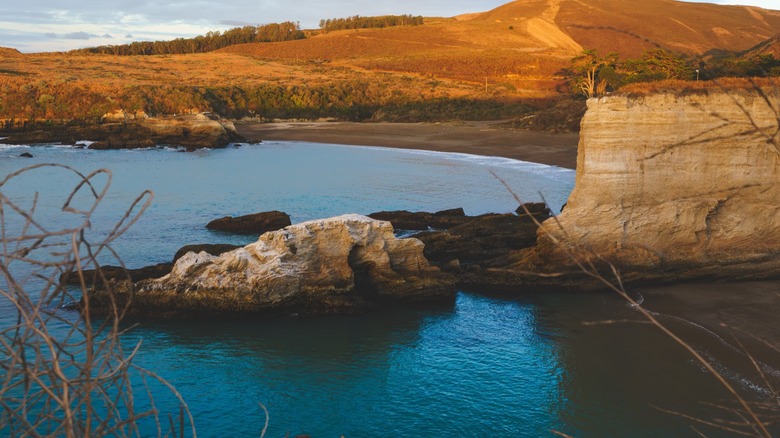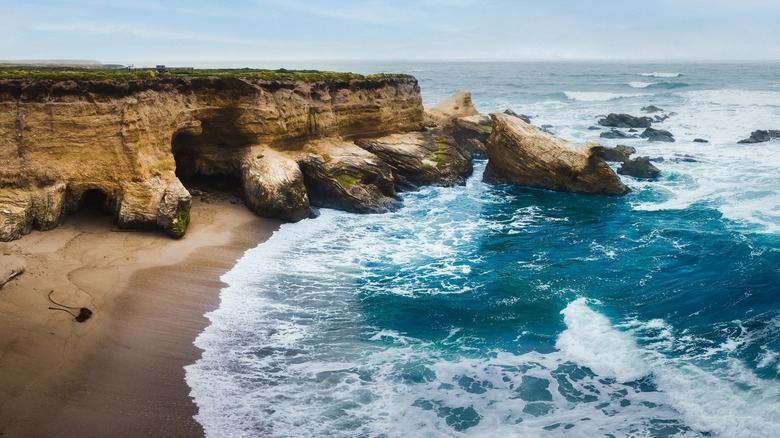Enjoy Unparalleled Mountain Views And Sandy, Secluded Beaches At This California State Park
In a state with an embarrassing wealth of national park treasures, the central coast of California boasts a hidden gem in Montaña de Oro State Park. The park sits between San Luis Obispo and the wild cliffs and crags of the Pacific coast only 15 miles west. It can be reached by driving west on Los Osos Valley Road until it turns into Pecho Valley Road, which leads you into the park. As one of California's largest state parks, the spread of Montaña de Oro, between population centers of Pismo Beach and Morro Bay, offers an abundance of beautiful solitude.
Along 7 miles of shoreline, sandy beaches and shallow coves are interrupted by slanted layers of fossilized mudstone deposits. These time-worn rocks create miniature islands, layered archways, and tide pools that are sized for privacy. For those with action on their minds, the park offers some great coastal California hiking trails as well as mountain biking paths, campgrounds, and horse trails criss-crossing the 8,000-acre park. The most intrepid mountaineers can reach an elevation of 1,347 feet at the Valencia Peak, where the springtime's yellow wildflowers make good on the park's Spanish namesake, the "Mountain of Gold."
Have a secret beach escape all to yourself
Montaña de Oro's dramatic coves and tide pools offer a visual feast that you might not have to share. Surprisingly, the coastal park doesn't crack California's top 30 most-visited state parks (it's no. 32), and its size and porous peninsula shape make it that much more isolated. That's according to the latest available statistical data for the parks from 2019 to 2020, as reported in the San Francisco Standard. There's even a beautiful coastal California town to visit, Los Osos, at the northern edge of the park that has pristine beaches of its own.
If you're venturing to one of Montaña de Oro's beaches, there's plenty to do and see. Hide out in your own personal cavern made of the park's signature Miguelito shale in the Coon Creek Beach tide pools, or descend the bluffs of Point Buchon Trail for a private beach. You can also find an individual cove between fingers of sand along the Bluff Trail. But be sure to pack layers for both hikes and beach days, as year-round moderate California temperatures can be dramatically cooler on the Montaña de Oro's coast than in inland California. Ready to see if people still exist? The park's most popular beach, Spooner's Cove, is a relaxed (and still relatively quiet) re-entry into society.
Where to camp in Montaña de Oro
For those Californians with the $195 annual state park pass, retreating to Montaña de Oro for camping ($25 to $50 with site reservation), hiking, wildlife-spotting, and swimming is a perfect escape — it's a great U.S. park destination if you want to avoid crowds. If you're a member of the California State library system, you can also check out a free day-use vehicle pass from your local library for your park visit.
Limited campsites with "primitive" amenities, the park's website explains, means no RV hookups, sanitation stations, or showers. This ensures you'll only be staying with a few fellow experienced isolationists on these grounds as you appreciate the rocky bluffs. RV and campground sites are located at Islay Creek Campground, just moments from picturesque beach and mountain views. While fire pits, toilets, and water spigots are found at the campsite, you can only access showers by visiting campsites at nearby Morro Bay. The same amenities are available at Hazard Canyon Horse Camp (yes, it's BYO-horse), which is set up for very small groups of horse-riding friends. But the serious "Into the Wild"-style loner can retreat to the dry environmental campsites, which the California State Parks' website warns are up to half a mile off the main trails and offer no potable water; the park's brochures do, however, promise however, pit toilets, potential coyote companions, and very starry nights.


